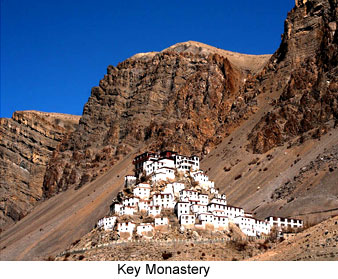 Key Monastery or Key Gompa is a Tibetan Buddhist monastery located on top of a hill at an altitude of 4,166 metres above sea level. Key Monastery or Key Gompa is located very close to the Spiti River, in the Spiti Valley of Himachal Pradesh.
Key Monastery or Key Gompa is a Tibetan Buddhist monastery located on top of a hill at an altitude of 4,166 metres above sea level. Key Monastery or Key Gompa is located very close to the Spiti River, in the Spiti Valley of Himachal Pradesh.
Key Monastery or Key Gompa is the biggest monastery of Spiti Valley and a religious training centre for Lamas. It reportedly had 100 monks in 1855. Key Monastery or Key Gompa is also famous for the Buddhist pilgrims to meditate. One can find perfect peace and solace while entering in the Key monastery.
Some of the scenes of Bollywood movie Paap, starring John Abraham and Udita Goswami, were shot at Key Monastery.
History of the Key Monastery
Key Gompa is said to have been founded by Dromton in the medieval era supposed to be 1008-1064 AD. He was a pupil of the famous teacher, Atisha, in the 11th century. This may however, refer to a now destroyed Kadampa monastery at the nearby village of Rangrik, which was probably destroyed in the 14th century when the Sakya sect rose to power with Mongol assistance.
Key Monastery or Key Gompa was attacked again by the Mongols during the 17th century, during the reign of the Fifth Dalai Lama, and became a Gelugpa establishment. In 1820, the Key Monastery was sacked again during the battle between the kings of Ladakh and Kulu. In 1841, the Key Monastery was severely damaged by the Dogra army under Ghulam Khan and Rahim Khan. Later that same year the Key Monastery suffered more damage from Sikh invasion. In the 1840s Key Monastery was ravaged by fire and, in 1975, a violent earthquake caused further damage which was repaired with the help of the Archaeological Survey of India and the State Public Works Department of Himachal Pradesh.
Architecture of the Key Monastery
The walls of the Key Monastery are covered with Buddhist paintings and murals. The mural paintings of Key Monastery shows an example of the 14th century monastic architecture, which developed as the result of Chinese influence in different parts of Himachal Pradesh. Key monastery has a collection of ancient murals and books, including the ancient figures of Lord Buddha. The monastery is famous for its architecture called Pasada style. Pasada style is characterised by two or more stories and often plays the role of a fort-monastery. There are three floors in Key Monastery. The first floor of the Key Monastery is mainly underground and used for storage. One room, called the Tangyur is richly painted with murals.
Attractions of the Key Monastery
Key Monastery is a place where one can experience peace, calm and peacefulness from the minute they go into the steps leading to the monastery. It is known for its antique murals and antique weapons and the images of Gautam Buddha in deliberation position are a must see. The stunning landscape is also a factor in the large number of tourists and enclosed by snow capped mountains and glaciers, the gorgeousness of the valley is breathtaking.
During the month of June and July, the Key monastery celebrates a festival, where the Chaam dancers are followed by a procession by lamas who reaches the ceremony ground below the monastery to perform dance and a large sculpture of a demon is set on fire and the devotees lays themselves down on the route, so that the lamas can walk over them as a part of a ritual. This festival is another attraction for the visitors.
Connectivity of the Key Monastery
The bus to Key Monastery leaves from Kaza everyday at 5 PM, and returns the next morning at 9 AM. Visitors can visit this place directly from Manali by travelling a distance of 210 km from Manali to Kaza and from Kaza to Key Monastery by taking a bus that runs daily.



















